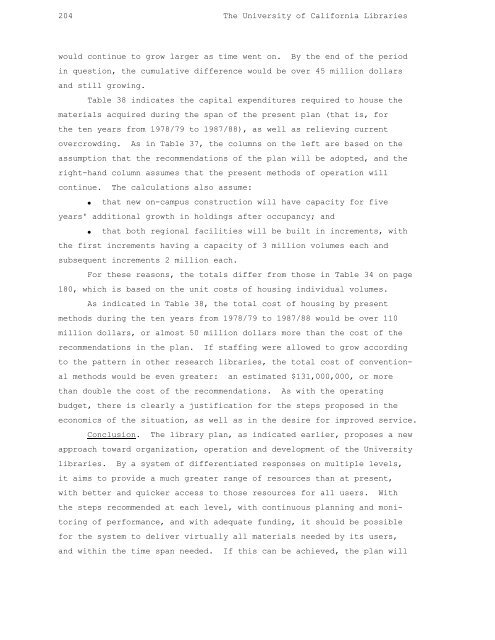The University of California Libraries: A Plan for Development (1977)
The University of California Libraries: A Plan for Development (1977)
The University of California Libraries: A Plan for Development (1977)
Create successful ePaper yourself
Turn your PDF publications into a flip-book with our unique Google optimized e-Paper software.
204 <strong>The</strong> <strong>University</strong> <strong>of</strong> <strong>Cali<strong>for</strong>nia</strong> <strong>Libraries</strong><br />
would continue to grow larger as time went on. By the end <strong>of</strong> the period<br />
in question, the cumulative difference would be over 45 million dollars<br />
and still growing.<br />
Table 38 indicates the capital expenditures required to house the<br />
materials acquired during the span <strong>of</strong> the present plan (that is, <strong>for</strong><br />
the ten years from 1978/79 to 1987/88), as well as relieving current<br />
overcrowding. As in Table 37, the columns on the left are based on the<br />
assumption that the recommendations <strong>of</strong> the plan will be adopted, and the<br />
right-hand column assumes that the present methods <strong>of</strong> operation will<br />
continue. <strong>The</strong> calculations also assume:<br />
• that new on-campus construction will have capacity <strong>for</strong> five<br />
years' additional growth in holdings after occupancy; and<br />
• that both regional facilities will be built in increments, with<br />
the first increments having a capacity <strong>of</strong> 3 million volumes each and<br />
subsequent increments 2 million each.<br />
For these reasons, the totals differ from those in Table 34 on page<br />
180, which is based on the unit costs <strong>of</strong> housing individual volumes.<br />
As indicated in Table 38, the total cost <strong>of</strong> housing by present<br />
methods during the ten years from 1978/79 to 1987/88 would be over 110<br />
million dollars, or almost 50 million dollars more than the cost <strong>of</strong> the<br />
recommendations in the plan. If staffing were allowed to grow according<br />
to the pattern in other research libraries, the total cost <strong>of</strong> conventional<br />
methods would be even greater: an estimated $131,000,000, or more<br />
than double the cost <strong>of</strong> the recommendations. As with the operating<br />
budget, there is clearly a justification <strong>for</strong> the steps proposed in the<br />
economics <strong>of</strong> the situation, as well as in the desire <strong>for</strong> improved service.<br />
Conclusion. <strong>The</strong> library plan, as indicated earlier, proposes a new<br />
approach toward organization, operation and development <strong>of</strong> the <strong>University</strong><br />
libraries. By a system <strong>of</strong> differentiated responses on multiple levels,<br />
it aims to provide a much greater range <strong>of</strong> resources than at present,<br />
with better and quicker access to those resources <strong>for</strong> all users. With<br />
the steps recommended at each level, with continuous planning and monitoring<br />
<strong>of</strong> per<strong>for</strong>mance, and with adequate funding, it should be possible<br />
<strong>for</strong> the system to deliver virtually all materials needed by its users,<br />
and within the time span needed. If this can be achieved, the plan will
















